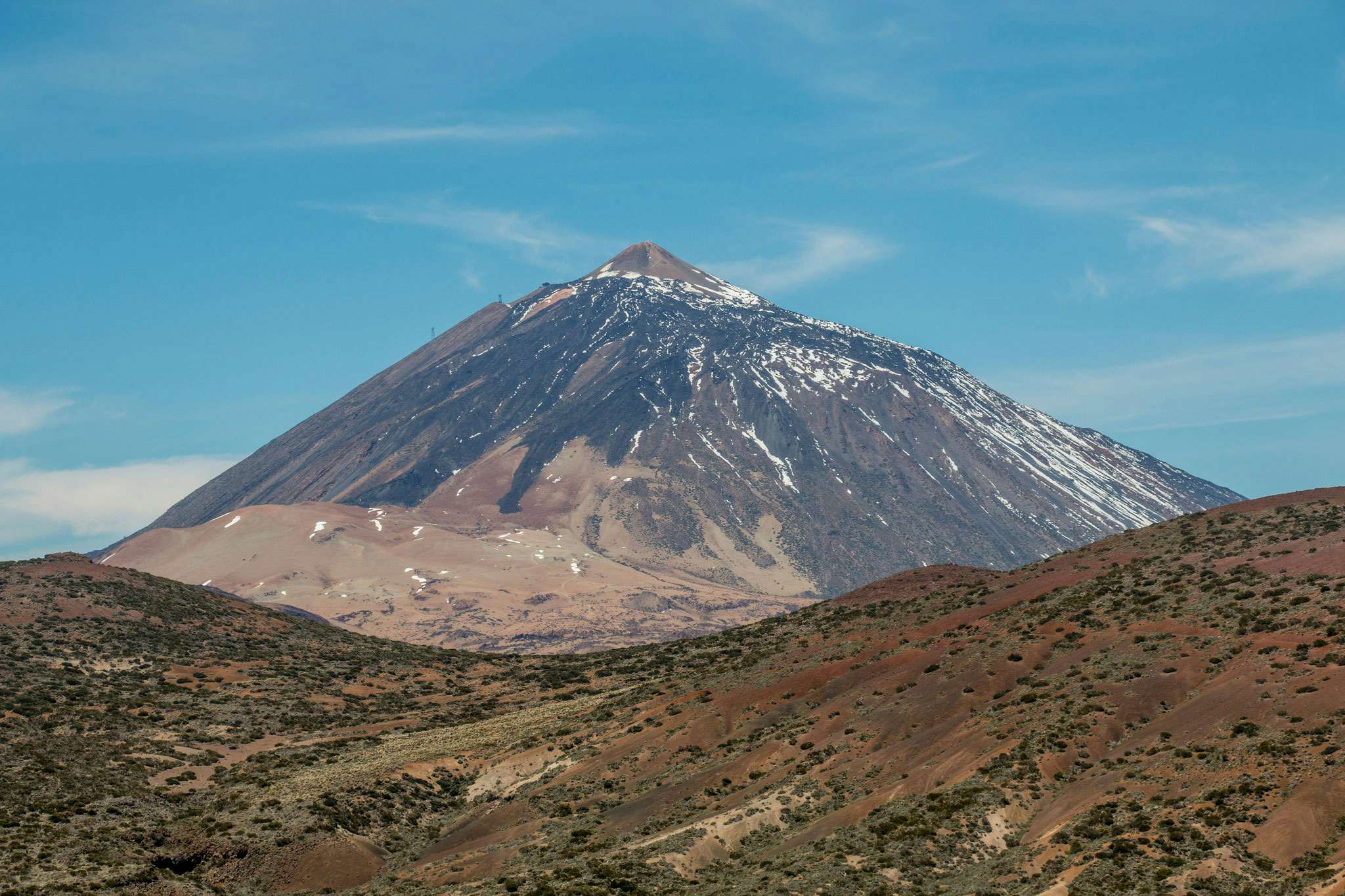At the moment (as of January 2024), the Altavista hut is closed. However, there is apparently an unlocked room with a few beds available for overnight stays.
To make sure that your hiking tour on the Pico del Teide, the highest mountain in Spain, is an all-round successful experience for you, you should know some information about the Teide, the tour and hiking in the heights in advance. Because I myself have done this hiking tour several times and have gradually learned a lot through my own mistakes. Therefore, I have compiled all the necessary information and worth knowing about the Teide and possible hiking tours for you from my own experience and knowledge.
So I wish you good entertainment while reading and an unforgettable hike. The Teide with its wonderful wild landscape offers everything. So a hiker can expect from exciting hiking tours with a high experience character.
First of all, an overview so that you can quickly find the chapters that interest you most.
Visitor magnet Teide
The Legend
Map
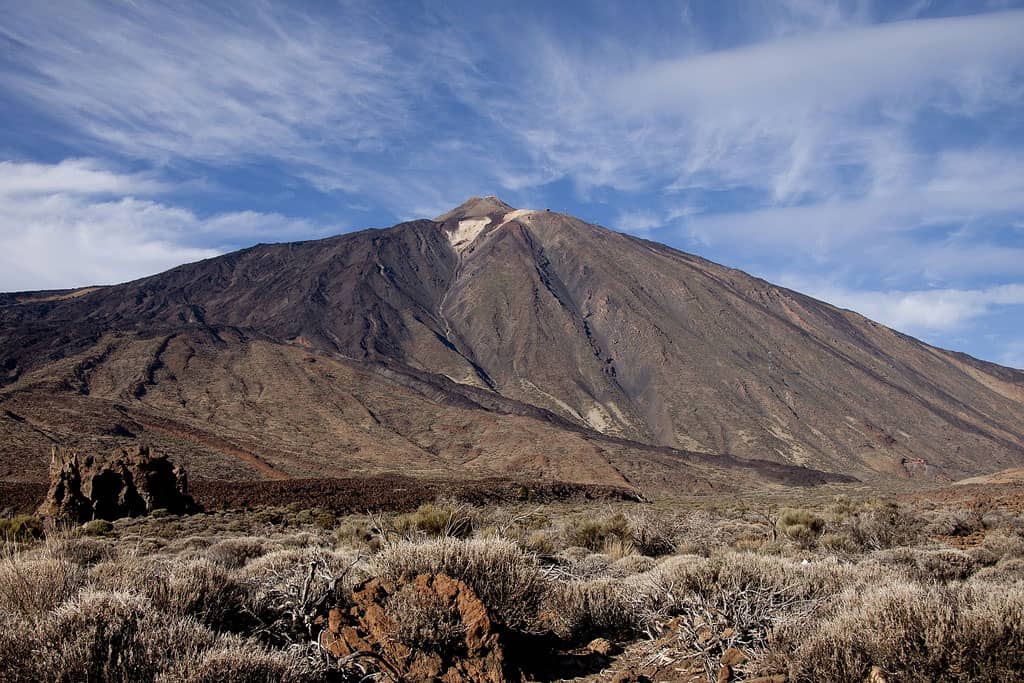
view on the Teide
Already during the landing approach to Tenerife, the largest volcanic mountain of the Canary Islands, the third largest in the world and also the highest mountain of Spain, the Teide with its 3718 metres of altitude, cannot be overlooked. The name of the “giant” Teide comes from the Guanche language. Primordially Guanches were the natives of Tenerife. And they described their mountain with the word “Eycheyde”, which means “home of the evil demon”. According to legend, the supreme god of the Guanches closed the Teide with a stopper. And that is named the El Pitón or sugar loaf.
View on the Teide
And indeed, in winter the Teide is mostly covered with a snow cap. From time to time, the whole Teide National Park is white and all access roads are closed. However, in summer the Teide is snow-free and often surrounded by futuristic cloud formations. Almost no holidaymaker comes to the island without at least having had a view from a distance to the mountain. And that dominates the island. So for some, the view from the plane or the passing by bus is enough.
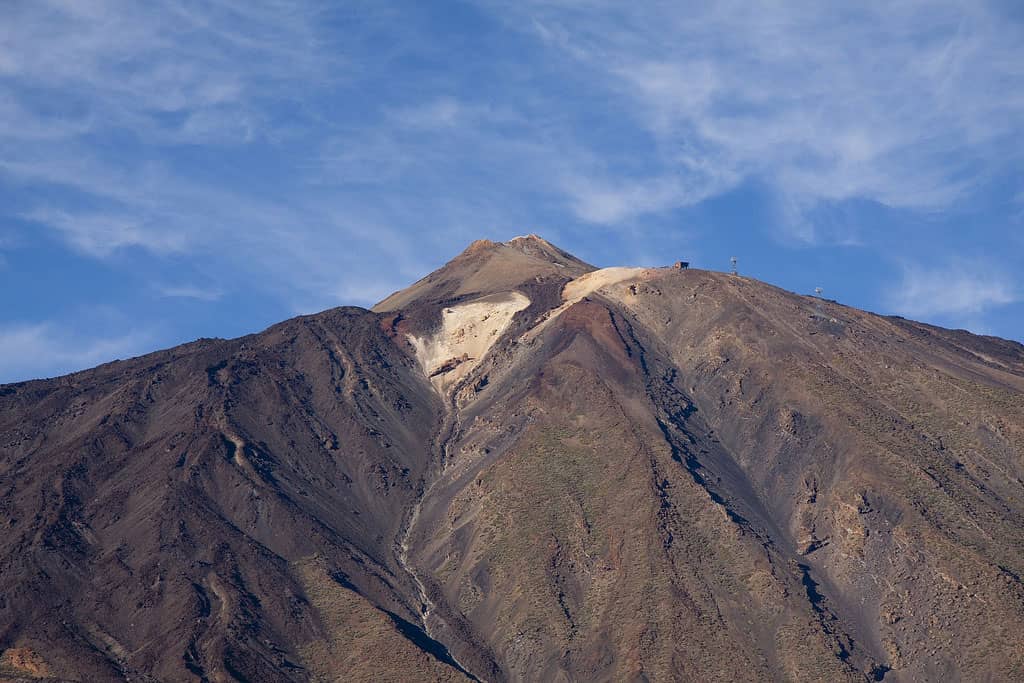
Teide top
Teide National Park as UNESCO World Heritage Site
Also during a walk in the Teide National Park, which was declared a World Heritage Site by UNESCO in 2007, the striking volcanic rock can be seen almost everywhere. Those who want to stay overnight near the Teide can do this in the Teide National Park. They can contact the state hotel Parador, Las Cañadas del Teide, 38300 La Oratava, Tenerife, canadas@parador.es.
If you want to visit Tenerife, you should not miss the visit of Teide. It is one of the sights that every visitor should see. And as beautiful as the Teide is to look at, the experience of hiking personally to the largest volcanic mountain in Spain is even more intense.
With the cablecar to the Teide
General information cable car
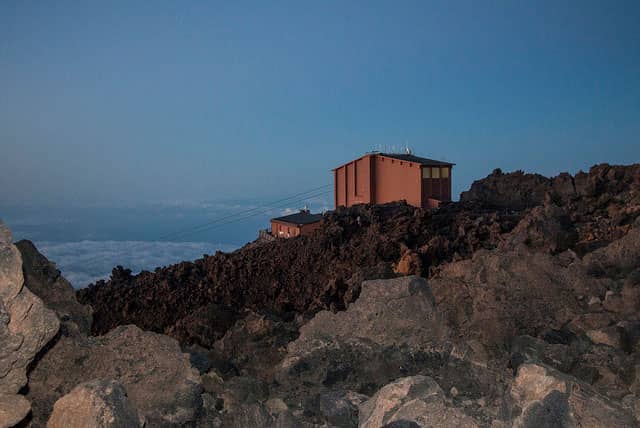
Teide - cable car station
Nearly 4 million visitors to Teide National Park
In recent years, the Teide National Park has attracted between 3-4 million visitors annually. And many of whom have also visited the summit of Teide (Pico del Teide). The cable car (Spanish: Teleférico) is the easiest way to get there. The valley station of the cable car is located at a car park directly next to TF 21, km 43. It is open from 9.00 to 17.00, with the last ascent at 16.00 and the last descent at 16.50.
In difficult weather conditions, such as storms and bad weather, it does not run. So don’t make the same mistake as I did many years ago. At that time I was tempted by the beautiful weather on the coast to visit the Teide with friends. And it wasn’t until we stood in front of the cable car station after 50 kilometres that we realized that it wasn’t going. So check the internet at www.volcanoteide.com (site also available in English) or at the local tourist offices. Cable car and Teide tours from the mountain station
Teleférico – the cable car to Teide
The large car park in front of the cable car valley station is open from 8.00 to 18.00 hrs. A single trip costs 13,50 € and the return trip 27 €. Further information and offers (tickets in connection with a visit to the nearby observatory) as well as the prices for children and residents can be found on the Internet under the given link. Since some time the tickets can be booked there also in advance.
Users can then use the “Fast Lane”. The big advantage is that long waiting times, which are always to be expected at the Teide cable car stations due to the high traffic, can easily be avoided. The cable car, with which 38 people can be transported, overcomes 1199 metres in less than ten minutes. It goes from the Cañadas Street TF 21 from 2356 to an altitude of 3555 metres.
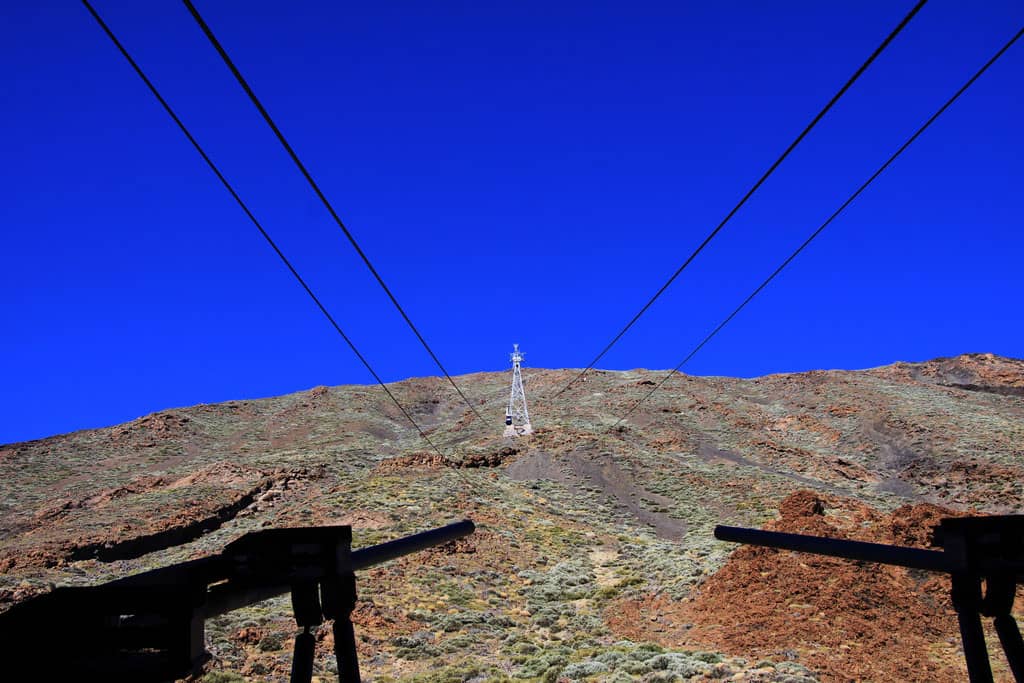
Teide cable car
Great view and exciting hiking routes
Those who take the cable car to the top station can enjoy a wonderful view of the entire National Park. From there they will see large parts of the coast and the neighbouring islands of Gran Canaria, La Palma, La Gomera and El Hierro. And from the edge of the crater La Rambleta, visitors can go to the viewpoints Mirador Pico Viejo (Tour 12) and Mirador de la Fortaleza (Tour 11) and via the Telesforo Bravo Trail to Pico del Teide (Tour 10). Information on the current condition of the trails can be obtained from the Teide National Park Administration on +34 922 92 23 71 or by e-mail at maot@gobiernodecanarias.org.
Hiking tour Mirador de la Fortaleza
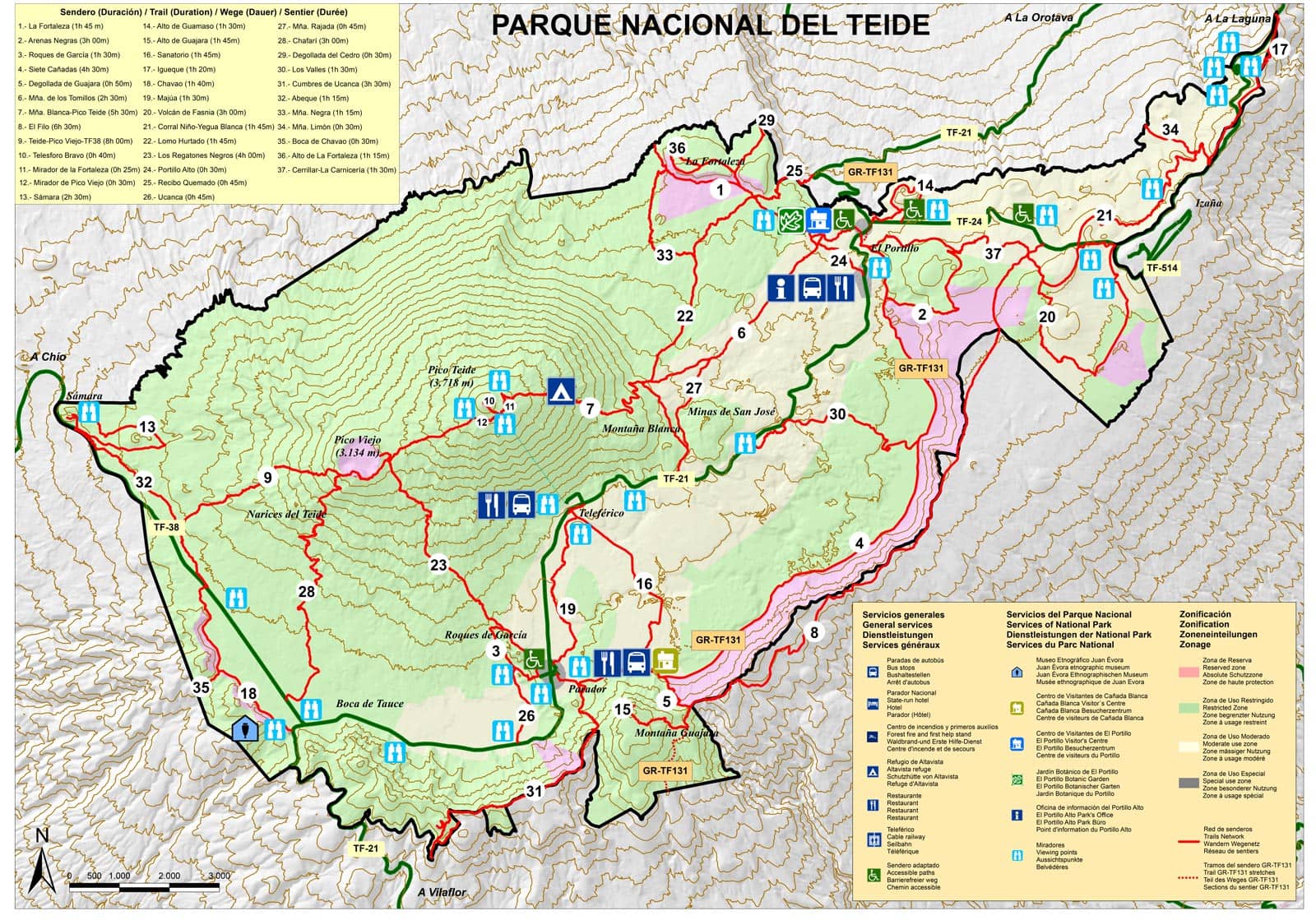
Teide Hiking Tracks
In the Teide National Park there are 21 marked hiking routes and this tour is called 11. However, the two small tours on the mountain station of the Teide are not really big hiking tours, but rather walks. The first small tour is barely one kilometre long and has hardly any ascents. But the height is noticeable during the movement and also the breathing is difficult.
The well recognizable, paved way to the Mirador de la Fortaleza leads from the mountain station to the northeast. It soon merges with hiking route 7, which comes from the Altavista mountain hut. The path has only slight gradients and offers excellent views of the northern side of Tenerife. As well you will see the Montaña Blanca and the black lava flow. If the sky should be cloudless, the view reaches over the Orotava valley to the forests and mountains of the Anaga mountains in the north. To your left rises the Pico del Teide.
And here’s the matching T-shirt Hiking tour Mirador Pico Viejo
The second major walk (hiking tour 12), which you can take from the top station of the cable car, heads west. Here we are talking about a 1.5 kilometre return trip, with only slight differences in altitude to overcome. From the Mirador you can see the first volcano in this region, the Old Teide. It is also called Pico Viejo or Montaña Chahorra with its 3104 altitude metres. The way there runs towards Pico del Teide, which is also called El Pitón. From the Mirador you can see the impressive crater of Pico Viejo, which has a diametre of 800 metres.
In 1798, the last volcanic eruption took place here on the Teide and lasted three months. From the craters of Pico Viejo, also called Narices del Teide, large lava flows flowed down the slope. Also from this Mirador there are incomparable views to the neighbouring islands La Gomera, La Palma and El Hierro as well as to the whole south coast of the island. The view of the Caldera, the volcanic cauldron surrounded by high mountains, is also impressive.
Pico del Teide on the Telesforo Bravo Trail
Teide Summit Permission
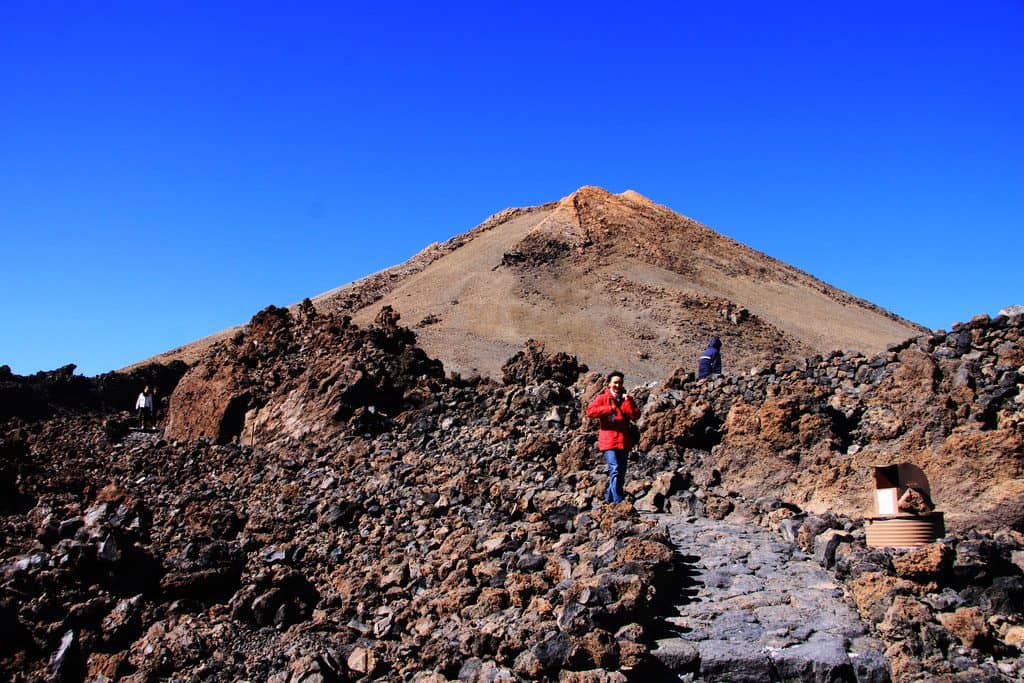
Teide - way on the top
If you like, you can also hike to the top of Teide. But this requires a special permit, which must be obtained in advance from the National Park Administration. That is either in the office Parque Nacional Teide, C/Sixto Perera Gonzáles 25, 38300 Orotava, Tenerife or
on the Internet at www.reservasparquesnacionales.es . Access to the “Pico” is limited for nature conservation reasons to prevent too many visitors from climbing the Teide summit at once. Each permit is valid for a period of two hours. During this time you can go to the top of Pico del Teide, 160 metres above the mountain station. If you want to reach the summit in this way, you should plan your tour in good time and obtain the necessary permission as early as possible. Often, the permits are already booked weeks in advance due to the limitation.
Teide – Ascent to Spain’s highest summit
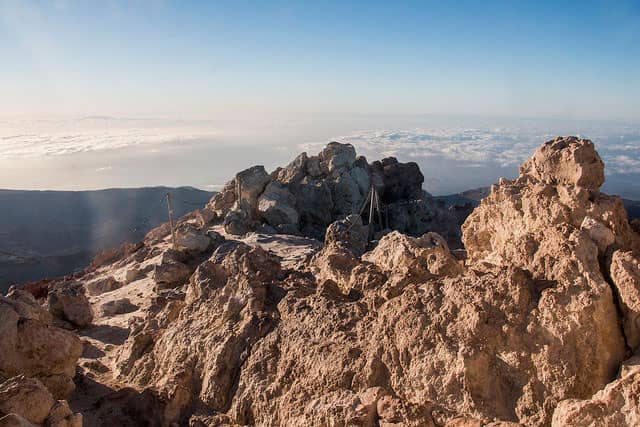
View from the top of Teide
This hike (route no. 10) to the Teide crater on the highest peak of Spain, the Pico del Teide, also begins at the top station of the cable car. The route of Tour 11 towards Mirador de la Fortaleza is short. But after a short time, the paved path to the summit branches off to the left. 160 metres in altitude have to be overcome on narrow serpentines steeply uphill towards the summit.
Breathing is difficult due to the altitude. In addition, there is a strong smell of sulphur, which makes the ascent a bit difficult. But when the summit is reached, the efforts of the ascent are forgotten. Because the views of all six neighbouring islands can be enjoyed without restriction in a cloudless sky. The view reaches on all sides of Tenerife, so that you can overlook the whole national park with the volcanic cauldron and the coastal regions of the north and south of the island. Also you are now very close to the small crater, which shimmers yellow-green and steams.
Teide Shadows – the largest shadow in the world
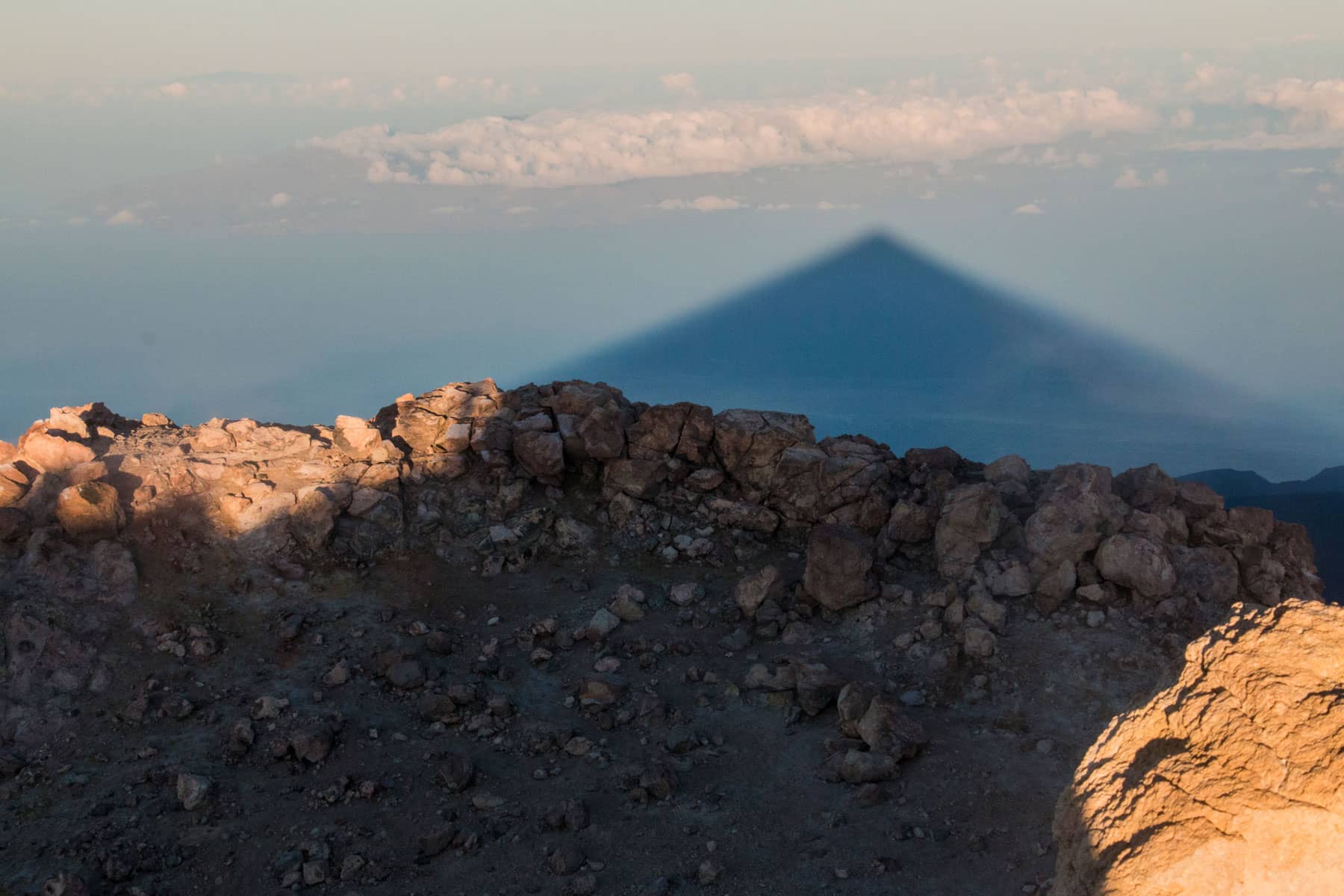
shadow of Teide in the morning
A special experience is to be on the Pico del Teide in the early morning at sunrise or in the evening at sunset. Then the Teide casts the largest shadow in the world on the sea. In the morning at sunrise, the shadow goes west over the sea to far beyond the neighboring island of La Gomera. The Teide shadow is special when the sunset coincides with the rise of the full moon, as then the moon also casts a Teide shadow.
It is also interesting that the shadow of the Teide has the shape of a pyramid, although the Teide summit does not have this shape. The fascinating phenomenon is a result of perspective. At sunrise and sunset the sun is so low that the shadow of Teide is cast very far. This smoothes out the details for the observer and the shadow only converges very far into the distance. In perspective the shadow therefore looks like a huge triangle.
Teide hike – in the footsteps of Alexander von Humboldt

Teide with Pico Viejo and Caldera
If you want to hike on the Teide, you can of course do so at any time of the day or night. During the day, when the weather is good, there are beautiful views of the entire island and a varied landscape to see. During the crossing, the white hills of the Montaña Blanca shine white and in the morning light orange to red. The large dark volcanic boulders, the Teide eggs (Huevos del Teide) form a contrast worth seeing. During a nocturnal ascent the sunrise can be seen and experienced with the impressive Teide shadow.
The hiking trail on the Teide is in many parts the same as the one Alexander von Humboldt took on his expedition in 1799. Humboldt came from Orotava and after an overnight stay on the small plateau Estancia de los Ingleses, climbed the Pico del Teide. Therefore you can follow the tracks of Alexander von Humboldt on this trail.
General information about the hiking tour Teide
Starting point
Parking at TF 21 on Cañadas road at km 40 about three kilometres after the cable car station towards El Portillo (2350 m above sea level). Sometimes it is difficult to find a parking space here. In this case I recommend you to avoid the parking places along the street or at the Parador Nacional. However, there are seven kilometres between the Parador and the starting point of the hike. Twice a day the bus lines 342 (Costa Adeje – El Portillo) and 348 (Puerto de la Cruz – Parador Nacional) drive along this route and stop at the starting point if desired. Further information about Titsa bus you will find on the homepage. Please do not leave any valuables in the car, as it happens from time to time that the windows of the cars parked there are smashed to steal valuables. Time
I don’t like to give general time information for hiking tours, as this depends very much on the condition and speed of the individual. To be honest, I also need more time for the tour and a little less for the tour. Here is a little rest. There still another photo. And the own condition depends on the daily form. But in general, up to the Teide summit an average of approx. 5 (+/-) hours and for the descent again approx. 3 (+/-) hours are counted. Also the weather, which can quickly turn into rain and snow in the colder season, plays a not negligible role (see also 6. Climate and Weather). Here the personal rest and break times are not yet considered.

elevation profile Pico del Teide
Difference in altitude and distance
Even if the difference in altitude is approx. 1370 metres, the total ascent on the approximately 8.5 kilometres long route must be over 1600 metres in altitude. Up to the Refugio de Altavista there are already 900 metres of altitude difference.
Equipment
warm clothes, gloves (all year round), sufficient water (at least 3 liters) and food, sun protection during the day and good headlights and torches for night hikes.
Requirement
difficult: All paths are well signposted, often wide and generally easy to walk. However, it is a very long tour at altitude with an ascent of over 1300 metres. Also the climatic conditions should not be underestimated. Low temperatures at high altitudes must be expected throughout the year, and occasionally ice and snow. In case of bad weather and storm, it is not advisable to climb the summit.
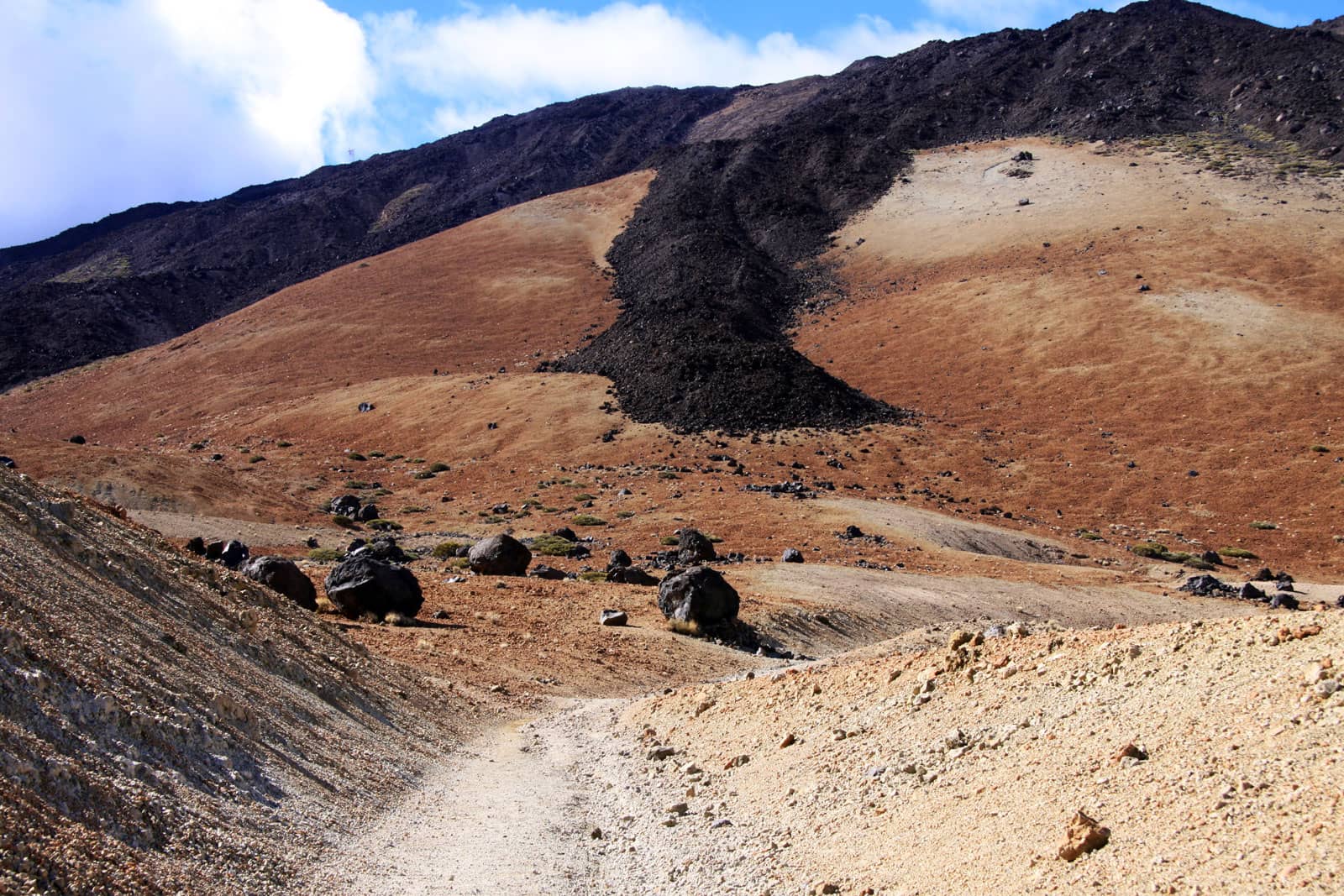
Teide - hiking route Montaña Blanca
Mountain sickness
Since the hike takes place at an altitude above 2500 metres, there is a risk of falling ill with altitude sickness. Headaches, dizziness, nausea and tachycardia may be first signs. If these symptoms are present, do not take any risks and better stop and descend the hike.
Very important: To avoid altitude sickness, drink enough and plenty of water to compensate for water loss and make it easier for the body to absorb oxygen.
Special feature of the National Park
The Parque Nacional del Teide is a protected area in which only the paths marked with numbers may be used. Abbreviations are not allowed. Nor is it allowed to take plants or stones with you. At the edge of the path you will find informative path signs, such as “Teide eggs”.
Teide tour with possible overnight stay in the Refugio Altavista on the hiking trail 7
Hike with or without overnight stay?
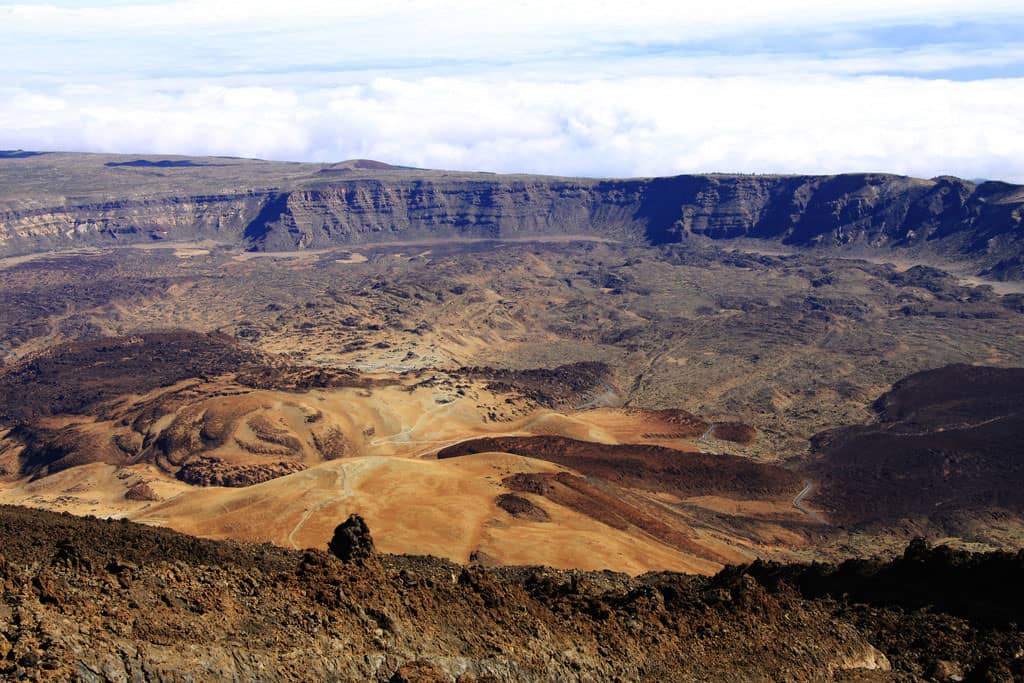
Teide caldera
Comfortable ascent with overnight stay?
A rather comfortable and still exhausting hiking option, for which about 16 to 20 hours have to be planned, is the tour to the Teide with an overnight stay in the Altavista mountain hut. If you choose the two-day option, you can hike to the mountain hut in the afternoon of the first day in peace and quiet, with light, and climb the summit the next morning and then descend again. This allows him to split the tour into two parts and make it calmer overall than the one-day tour.
If, on the other hand, you prefer to do the ascent and descent in one day, this is also possible, but much more strenuous compared to the first variant. Those who want to experience the sunrise on the summit in this way have to start in the middle of the night at the parking lot and will be back at the earliest in the late morning.
Summit trail without a permit ?
However, it is also possible to start in the afternoon and enjoy the sunset on the summit and then walk back in the dark. In the past, it was possible to climb Mount Teide without a permit if you stayed overnight in Altavista or before 9.00 am and after 4.00 pm. The prerequisite was that the Teide summit trail was left by 9.00 am at the latest or only entered after 4.00 pm. Today, however, you always need a permit, even for these times. However, night permits are easy to obtain online and are also more frequently available than day permits, which are often sold out months in advance.
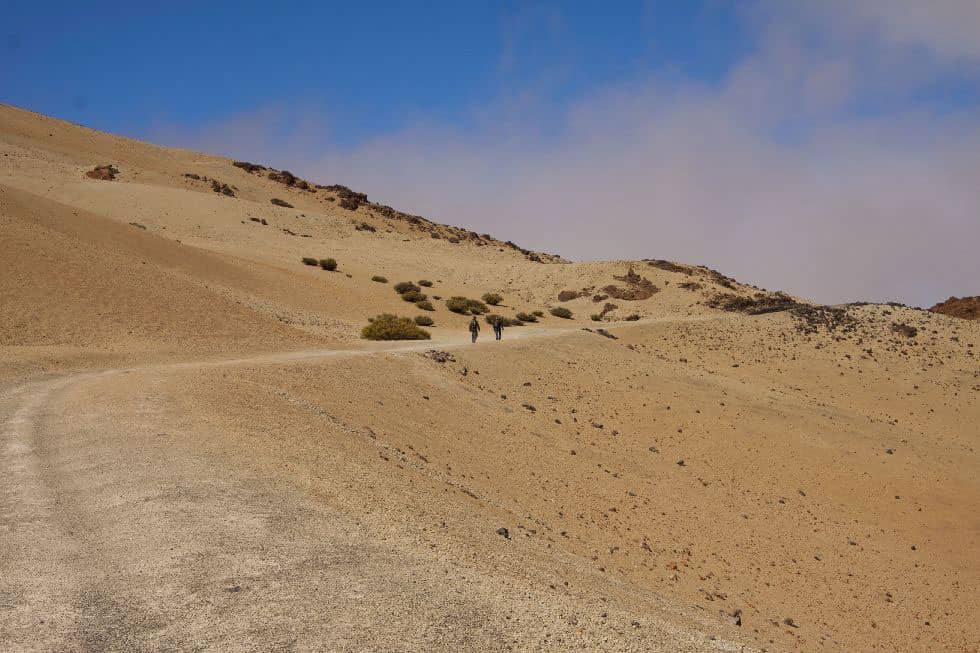
hikers on the path Montaña Blanca
If you like, you can also take the cable car after a strenuous night hike. Finally, there are a few variants, of which you will surely find the one that suits you.
Description of the path to the Refugio Altavista mountain hut
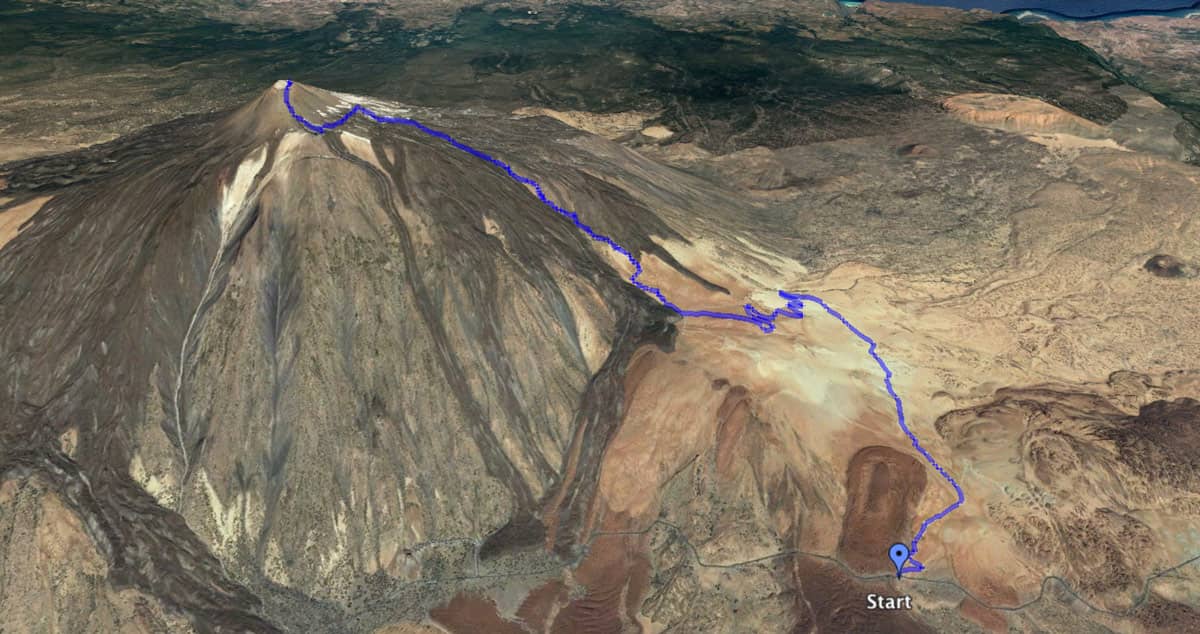
Track Pico del Teide
Parking until summit Montaña Blanca
From the car park at the TF21 (km 40.6), a broad, signposted road leads in the direction of Teide, which initially climbs only gently through the light beige pumice slopes. The wide path climbs up the Montaña Blanca slope in wide serpentines. To the left and right, after some time, the so-called black Teide eggs (Huevos del Teide) appear.
These eggs are dark rocks made of black lava rock that remind of large eggs and stand out impressively against the white pumice stone.
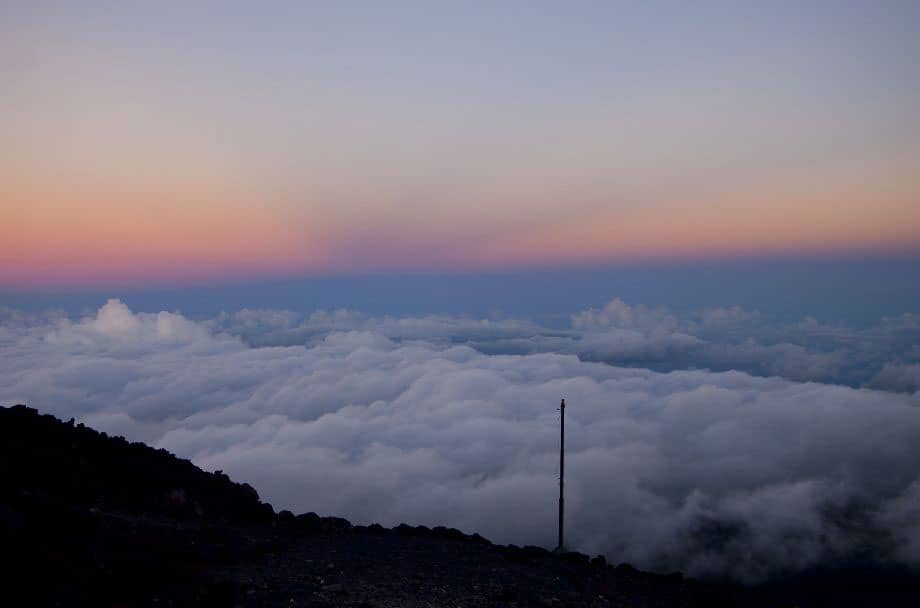
Teide sunrise with clouds
After about 1.5 hours you almost reach the summit (2748 m) of the Montaña Blanca. The path climbs up on the left, while it turns right towards the Teide, signposted. Those who want can make a small detour to the summit plateau of the Montaña Blanca. The ascent takes about 15 minutes. But at the top, there is a wonderful view to the surroundings and the ascent path to Altavista.
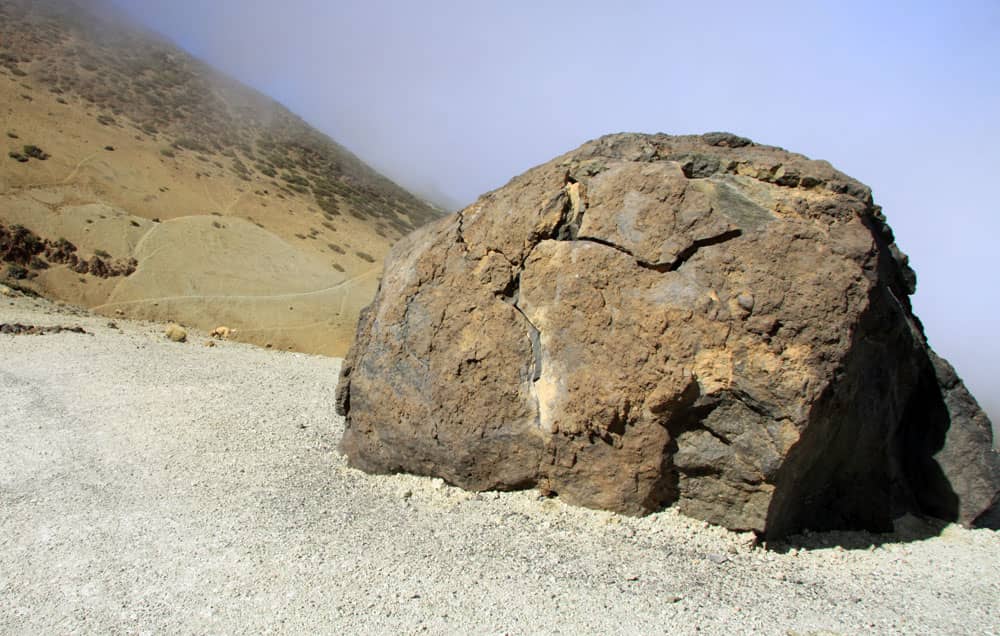
Teide egg
Ascent to the Altavista mountain hut
After this possible small detour, the actual steep ascent to the Altavista mountain hut (Refugio de Altavista) begins. It goes on a narrow path steadily steeply up the mountain. After some time you pass a small plateau with boulders, the Estancia de los Ingleses (stay of the English). Alexander von Humboldt camped here during the Teide ascent. Shortly thereafter a similar plain comes, called Estancia de los Alemanes (stay of the Germans). It goes further steeply uphill.
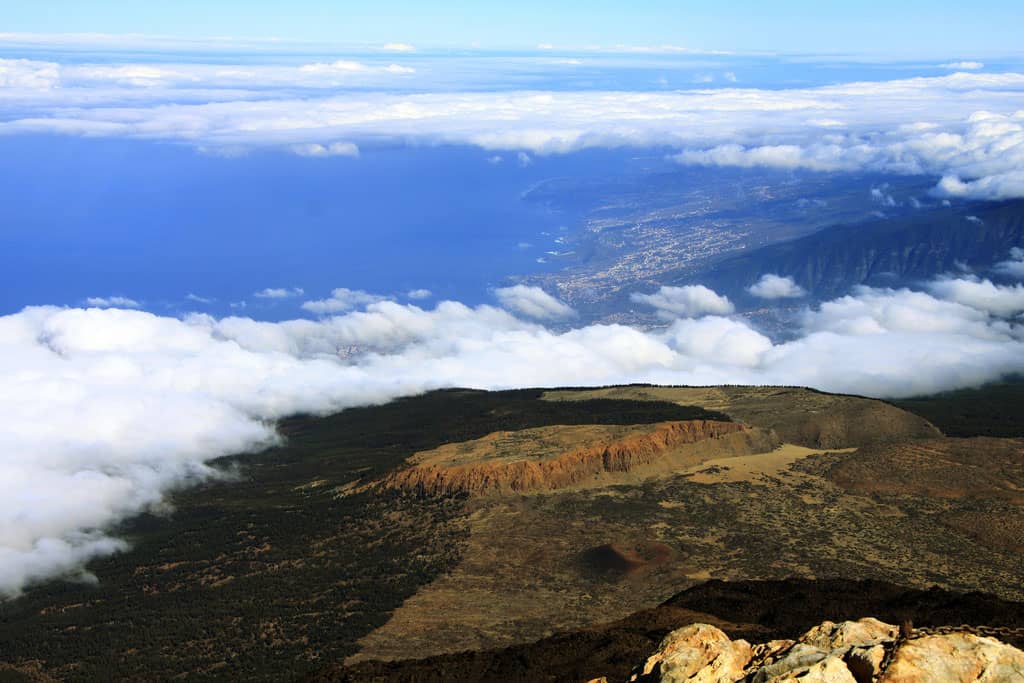
Teide view North side
After some time, this rise is interrupted again by a flatter field on which broom grows. The Teideginstern blooms from May to June. But enjoying the broom for a long time generally does not remain, because the next slope is waiting.
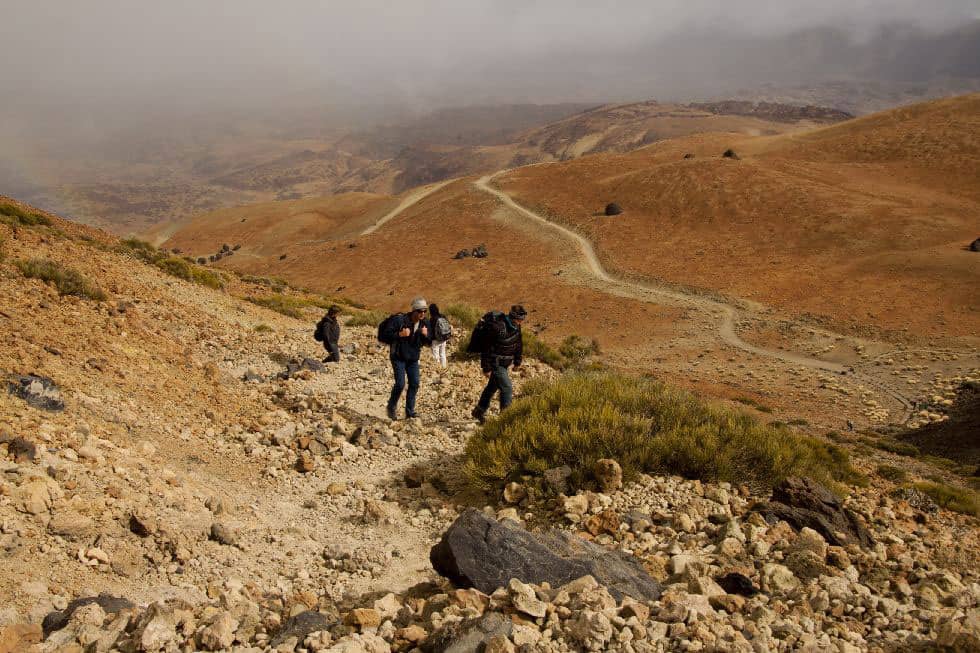
Hikers on the way up to Altavista
Article summary and large selection of GPS hiking tracks
Sign up for my newsletter now and get exclusive access to my collected GPS tracks as well as all the brief information about my articles.
Sign up nowIt’s the last big climb before Altavista. But this one goes up again very steeply over rocks and boulders. Then you first see a mast and suddenly, at a height of 3260 metres, the refuge Altavista suddenly appears in front of you.
Overnight stay in the mountain hut Refugio Altavista
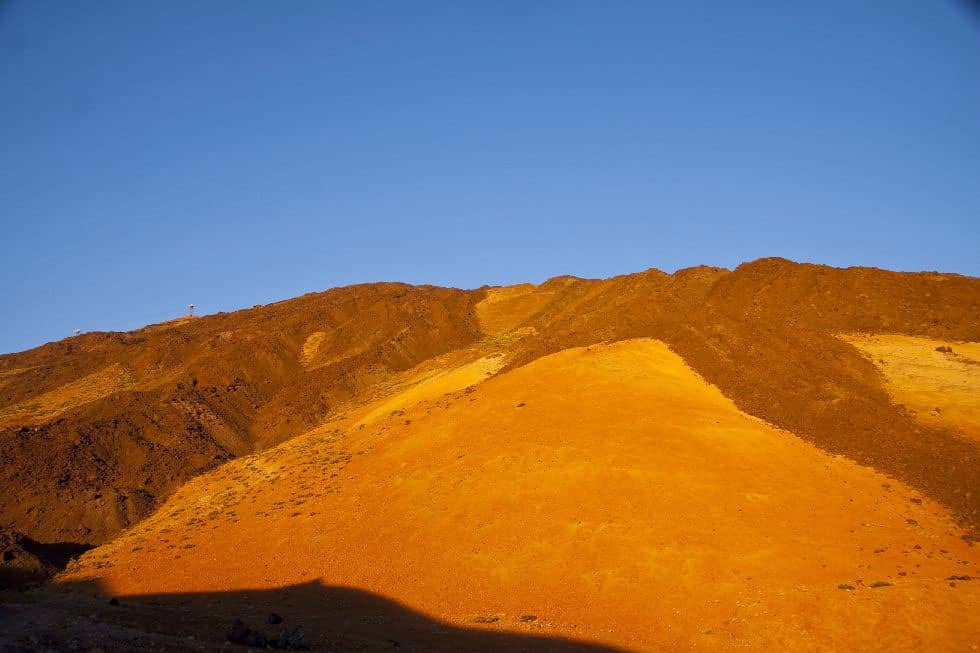
Montaña Blanca in morning sun
Mountain hut with a long history
The origins of the Altavista refuge date back to 1856. Originally it was used as accommodation for scientists and researchers. In 1950 the island administration of Tenerife took over the hut. The last time the cottage was extensively renovated was in 2007. Everything worth knowing about the Refugio Altavista can be found on the Internet at www.volcanoteide.com, which is also available in German. Registration and booking for an overnight stay are possible on this page, but should be made in good time. Prices and opening hours of the Altavista mountain hut
The overnight stay costs 21 € on special days (marked orange) and otherwise 25 € per person. And the price includes bed linen, use of toilets and kitchen, as well as accommodation in one of the three shared dormitories (54 beds in total). The overnight stay in the cabin is limited to one night, while the kitchen and toilets are open from 17.00 until 22.00.
You have to leave the mountain hut before 07.30 of the following day. The lounge is open from 11.00 hrs and the bedrooms from 19.00 hrs. Any waste must be taken with you. Even if the hut is equipped with heating, it can get quite cold, especially in the winter months. When I belonged with a stay to the “freezing”, I was glad that there were at least in the dormitory sufficiently warm covers on the beds.
Hiking trail from Altavista to the top station of the cable car

caldera - overview from the top
Excursion into the ice cave
To the left of the Altavista refuge, the path (marked path no. 7) leads through a lava flow to the top station of the cable car. The ascent is now a little steeper over small paths and lava rocks.
Note that after 15 to 20 minutes (approx. 100 metres above Altavista) a small marked path branches off to the ice cave (Cueva de Hielo). Alexander von Humboldt already mentioned this ice cave in his notes about his trip to Tenerife in 1799. The ice cave is, as the name suggests, iced all year round. Who still has time should make a small excursion. However, the cave is closed off with a chain; probably to protect it from too many “visitors”. That there is also no sign anymore that points to the entrance of the cave. But still, there is a long iron ladder through which it is possible to get into the cave that is approximately 50 metres long.
From the ice cave to the cable car station
Then we continue on the main path uphill through rocky rock. On the right you can see the Pico del Teide. After about an hour’s walk from Altavista you will reach Rambleta, a flattened slope. The Mirador de Fortaleza (see 2.2) is 50 metres to the right. And on the Rambleta you will also find the upper crossroad. That is a panoramic path that will take you in a short time to the left, on the east side of the Teide, to the top of the cable car station (3555m). So from here it takes about 20 minutes to reach the summit of Teide (see 2.4.2).
Teide Hike – Variants
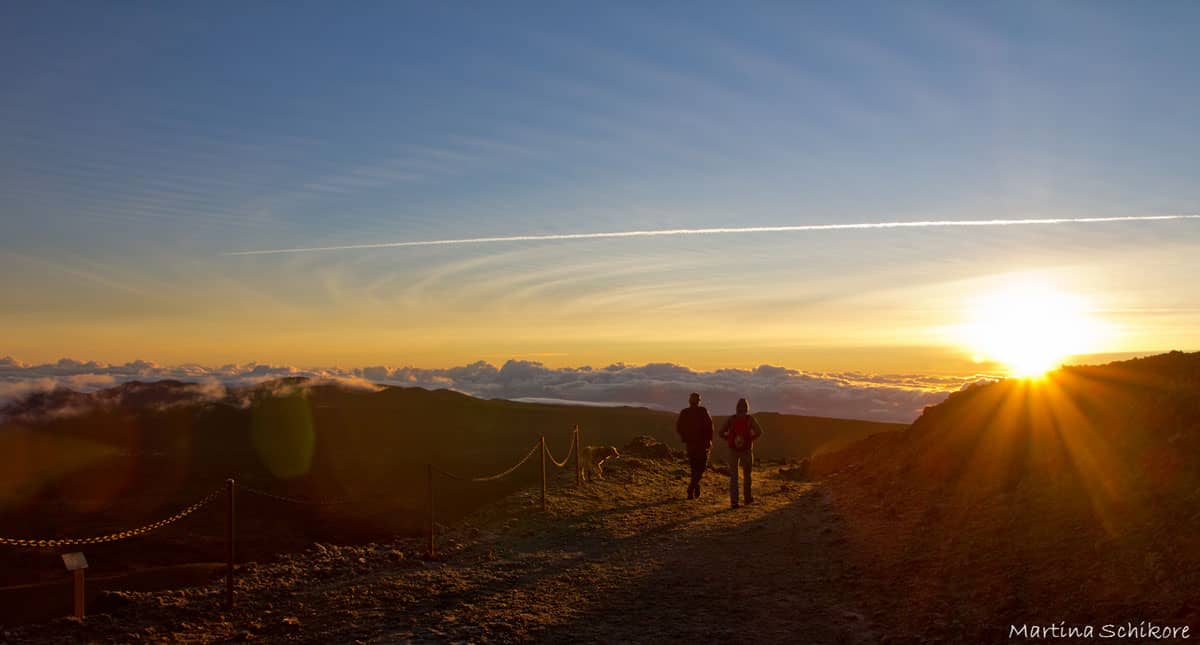
Hikers at sunrise Montaña Blanca
The tours described here with and without cable car can of course be combined as desired. It is therefore possible to take the cable car to the top station and descend via Altavista and the Montaña Blanca after the summit ascent. On the other hand, there is nothing to be said against descending the Montaña Blanca and Altavista with the cable car after a strenuous ascent. One has to consider in particular the summit permit that is required at certain times (see above) and a timely booking of the overnight stay in Altavista (optional). If you want to experience the sunrise or sunset on the summit, you should plan your arrival and ascent times well.
Apart from the routes described here, which all lead over the Teide, there is also the possibility to ascend or descend over the old Teide (Pico Viejo) on different routes. These tour is described here. On the Teide with dog
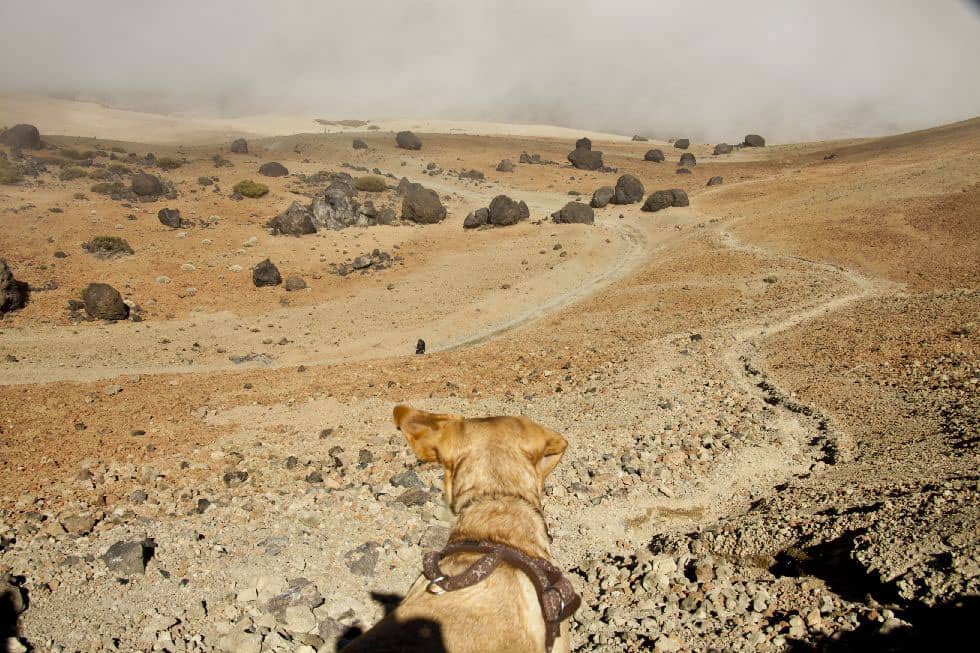
hiking with dog
Altavista with dog? Better not
As a dog-owner, who has already walked the Teide Tour to Altavista with her dog, I would like to give some hints for people, who want to walk on the Teide with their dog. Note that Dogs are forbidden in the cable car to the Teide, so that this variant is not possible for dog owners. And please don’t leave your four-legged friends behind in the car at the cable car station, because there is no shade there.
And dogs are also not welcome at the Altavista mountain hut. If you want to spend the night there with your dog, you have to leave your four-legged friend at the door of the refuge. Before my first hike to Teide I had read in Internet an article that dogs are permitted in the hut Altavista. And so I brought my dog up there in cold November. A mistake due to wrong information. But as an exception, after a long discussion I was allowed by the landlord of the hut to put him on a blanket in the porch of the hut. That was not very nice for him, but better than sleeping outside in the cold. A second time I would not get involved in this venture.
Man and dog have to be fit
Since the human requirement for this hiking tour is to be classified as difficult, the same applies to the dog. The dog should therefore first have the appropriate condition. Note, that the dog must be able to cope with the cold at height and also love climbing a little, because there is water on the way exclusively in the Refugio de Altavista, so that also sufficient water for the dog on the way is to be thought. The hiking tour to the Teide only starts on sandy ground. Later, however, often over pointed rocks and volcanic ground. Therefore, it is advisable to put dog shoes on the dog, which will not only protect him from pointed boulders, but possibly also from ice in bad weather conditions.
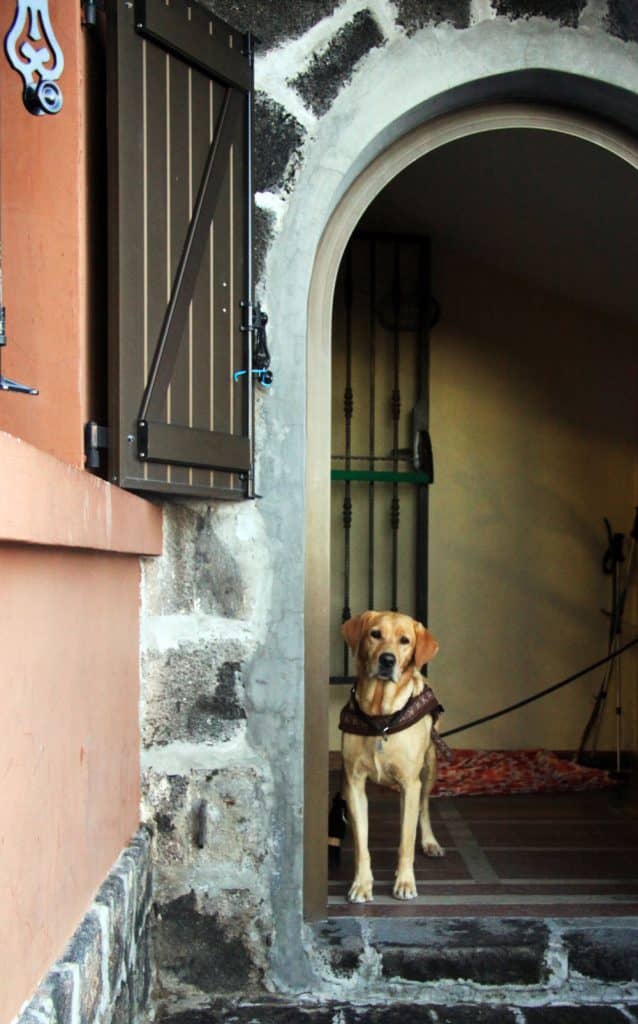
dog in Altavista
Climate and weather around Teide
Microclimate in the National Park
The Teide National Park has a microclimate that is very different from the rest of the island and especially from the coastal climate. Due to the altitude alone, the weather in the upper areas of Teide is different from that in the lower areas of Teide National Park. Apart from the snow in winter, it is usually cooler and windier up there than on the coast of the island. And the air is thin at an altitude of over 3000 metres and when the sun is shining, the radiation is intensely noticeable. In summer, temperatures of over 40 degrees Celsius during the day are not a special feature of the national park. And at night the temperatures fall extremely.

caldera
Those who drive up from the coastal towns to the Teide National Park must therefore expect completely different climatic conditions and have to adjust their clothing to the cold and heat. A warm jacket and sun protection are definitely included. But not only the weather in the bathing resorts and at the coast, which is mild during the whole year, differs extremely from the climate in the national park Teide. Also within the national park there are very different weather conditions depending on the heights of the individual regions.
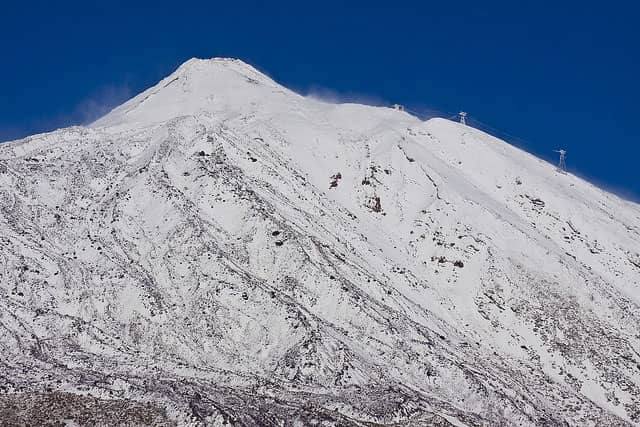
Teide covered with snow
Cloud layers and snow
During the winter months, a thick layer of cloud often hangs at an altitude of about 2000 metres. Below it is grey and rainy. But whoever drives through the cloud cover is suddenly in the sun. The mountains around the Teide and the Caldera lie above the clouds and there is a blue sky with bright sun. Only very rarely are there clouds above the heights of the national park. In this case these are often single cloud formations that lie around the summit of the Teide. The climate in the national park is at least in the summer months very dry.
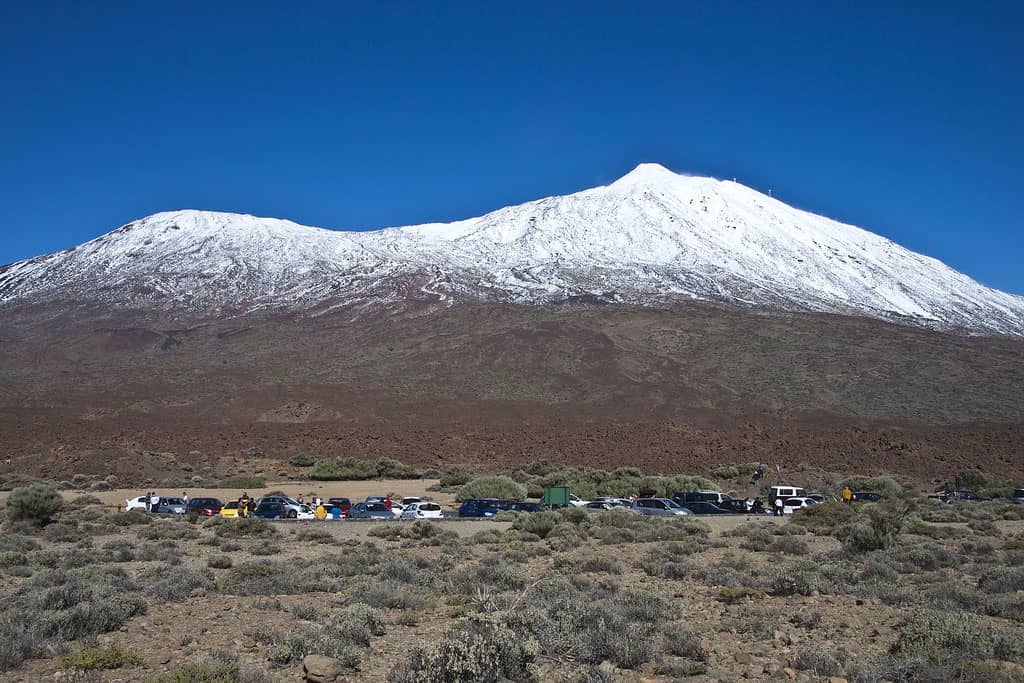
Teide in snow
In addition to temperature fluctuations, rapid weather changes must also be expected, especially in the winter months. Sun, rain, wind and even snow are common at these altitudes. So in winter there is often a small to thick layer of snow on the Teide. Every now and then it snows in the national park. And when it snows, it usually snows properly, so that the access roads to the national park are closed due to the large amounts of snow. Also the cable car does not go then and an ascent to the summit is also not allowed.
Stargazing at Teide
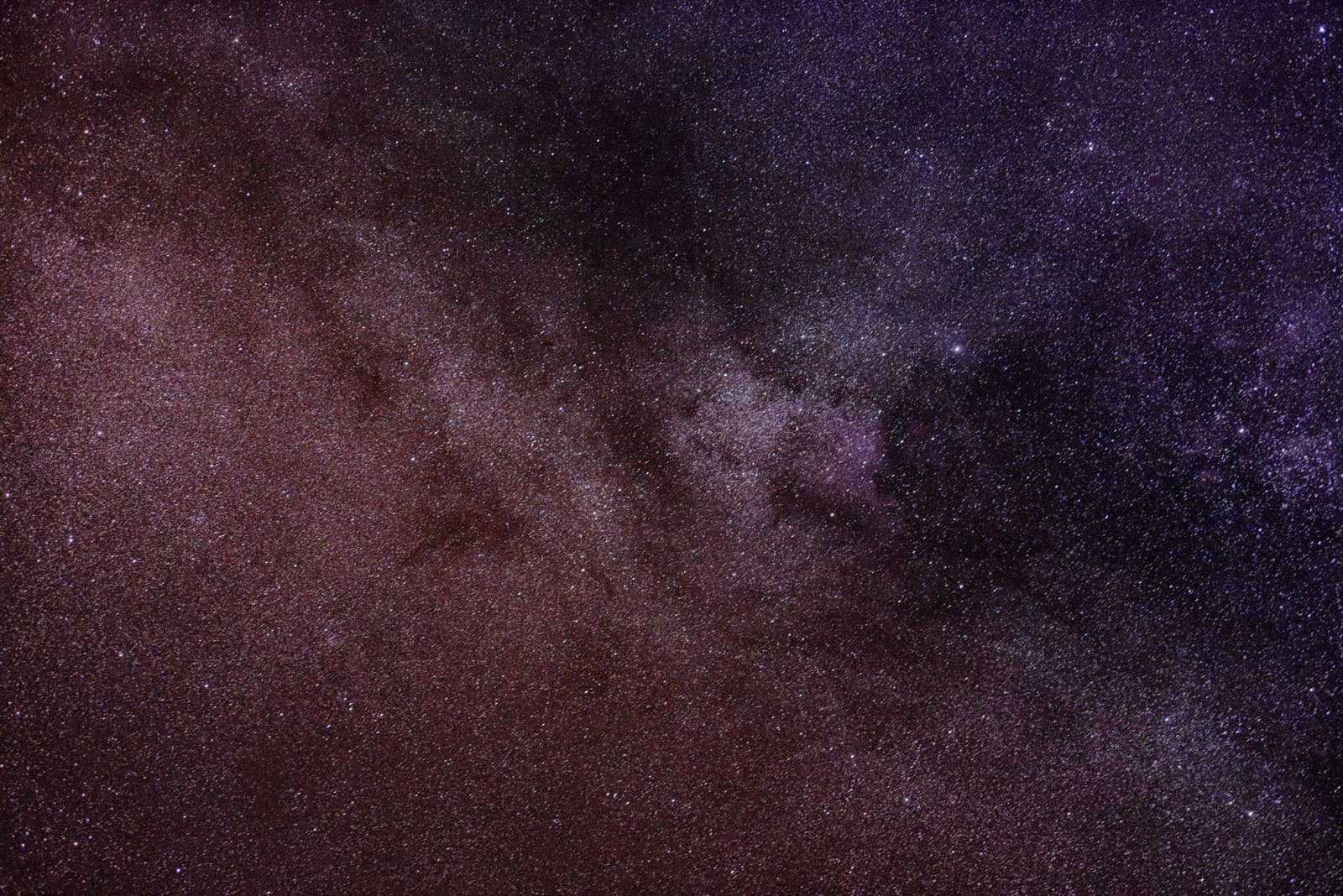
Teide starry sky
Magic place
The Teide used to be a magical place for the locals. And it also seems to have a great fascination for the people of our time who visit it day and night. For lovers of the night sky and stargazing, the Teide National Park in the Cañadas del Teide offers a wonderful natural platform.
What the Astrophysical Institute of the Canary Islands runs professionally is basically open to everyone here when they travel by car to the Teide National Park at night or spend the night in the state hotel Parador. And for those who prefer to observe the stars in an organized group, Tenerife offers different star observation tours on which they can observe the stars.
No light pollution due to altitude
The reason is the altitude of over 2400 metres above sea level, which is free of any light pollution. As a result especially on clear new moon nights the observer is offered an indescribable star spectacle. And who wouldn’t want to see the seemingly infinite Milky Way we live in in the sky?
Focused offerers on Tenerife, which specialized in the star observation, place the entire equipment, information and qualified personnel. Different night excursions are offered and organized. These tours can also be combined with a cable car ride on the Teide, for example to watch the sun go down. And if you wish, you can also enjoy a glass of sparkling wine followed by a “star menu”. So you can find out more here. And finally
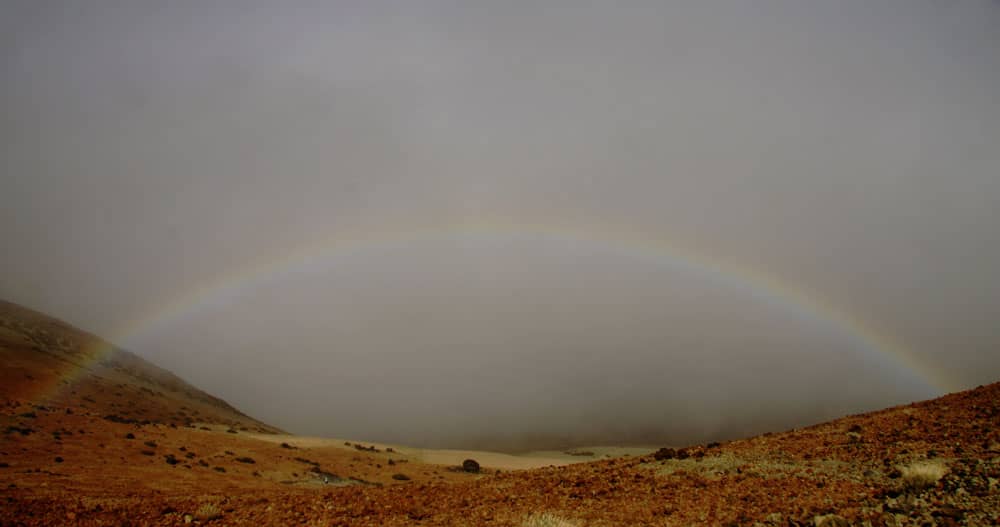
rainbow over Montaña Blanca
The area of the Teide National Park covers approximately 190 square kilometres. As a result you can imagine that there is still a lot to say and write. This article contains only the most important information to see and visit Teide in a relaxed way. So to make it a little easier for you to read and organize, I have written a summary with the most important details of this article.
And now I wish you much joy in discovering the Teide. If you like the article, I would be glad about a comment. Write me about your own Teide trip and your experiences. Thanks for visiting my blog and safe hiking,
Dagmar von Siebeninseln


















